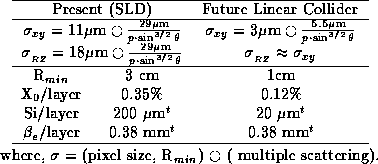There have been two R&D programs [19, 18] concerning vertex detectors toward experiments at linear colliders, both of which are based on charge-coupled devices(CCDs).
The JLC group has concentrated on a CCD of 25![]() m pixel operating at room
temperature(
m pixel operating at room
temperature(![]() C) with good radiation hardness, although the existing
device(SLD-CCD) is set in a cryostat at
C) with good radiation hardness, although the existing
device(SLD-CCD) is set in a cryostat at ![]() C as the other program. The main R&D
items are to use a silicon-wafer with higher resitivity(
C as the other program. The main R&D
items are to use a silicon-wafer with higher resitivity(![]() 1k
1k![]() cm) and a
thicker depletion region (
cm) and a
thicker depletion region (![]() 30
30![]() m) in order to improve the S/N ratio. The shot
noise (
m) in order to improve the S/N ratio. The shot
noise (![]() ) has been measured to be 40 e(electrons) in 0
) has been measured to be 40 e(electrons) in 0![]() C
at a readout frequency of 63kHz, and is thus expected to be 10e at
1MHz. [21, 20] Since a minimum ionizing particle (MIP) creates about
1,200 e (
C
at a readout frequency of 63kHz, and is thus expected to be 10e at
1MHz. [21, 20] Since a minimum ionizing particle (MIP) creates about
1,200 e (![]() 35e), it fills the principle requirement if it is operated
in 0
35e), it fills the principle requirement if it is operated
in 0![]() C. The next event will be a test of the radiation hardness.
C. The next event will be a test of the radiation hardness.
C.Damerell has suggested the ultimate performance for future linear colliders based on
experience with the SLD-CCD detector, which is the first full custom design
for high energy experiments. [18]
The performance and some requirements are listed in Tab.1.
In order to put the detector at R![]() =1cm from the beam line, the hit density due to
background must be less than 2/mm
=1cm from the beam line, the hit density due to
background must be less than 2/mm![]() per train crossing there. Since this tolerable
limit is already at R
per train crossing there. Since this tolerable
limit is already at R![]() =2cm in B=2Tesla for JLC-I, as described in 3.3,
a high solenoid field of 4 Tesla is needed to control the background.
The thinnest layer configuration of the detector will be provided by 20
=2cm in B=2Tesla for JLC-I, as described in 3.3,
a high solenoid field of 4 Tesla is needed to control the background.
The thinnest layer configuration of the detector will be provided by 20![]() m silicon
with a beryllium stiffener. He also speculated that the readout rate must be more than
20MHz in the future with a careful design of the readout circuit.
m silicon
with a beryllium stiffener. He also speculated that the readout rate must be more than
20MHz in the future with a careful design of the readout circuit.

Table 1: Present and future performances of 25![]() m pixel CCD detectors.
m pixel CCD detectors.
D.Jackson cleverly demonstrated the superiority of the SLD-CCD detector by a topological
vertex reconstruction. [22]
For instance, the SLD obtained ![]() with better accuracy
than the DELPHI; even the SLD has only 10% statistics(hadronic Z decays) of
that of DELPHI. For future linear colliders, the goal is to reconstruct primary, secondary
and tertiary vertices in order to identify charm and bottom quarks exclusively by the
topological method.
The bench-mark physics would be a measurement of the branching ratio of
with better accuracy
than the DELPHI; even the SLD has only 10% statistics(hadronic Z decays) of
that of DELPHI. For future linear colliders, the goal is to reconstruct primary, secondary
and tertiary vertices in order to identify charm and bottom quarks exclusively by the
topological method.
The bench-mark physics would be a measurement of the branching ratio of ![]() for determining the
for determining the ![]()
![]()
![]()
![]() parameters. [23]
parameters. [23]